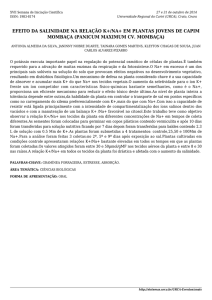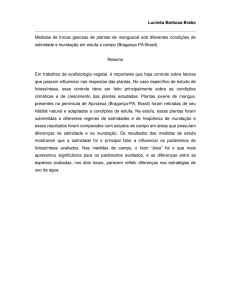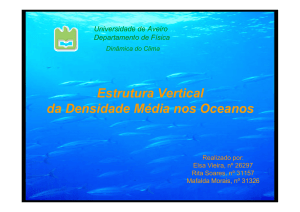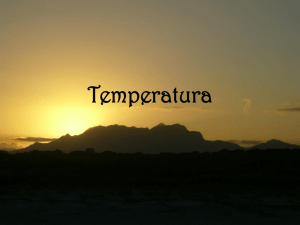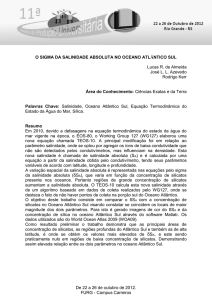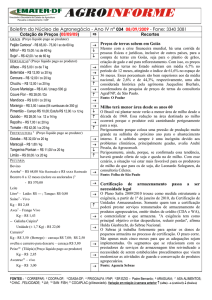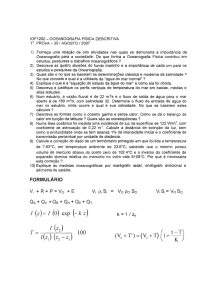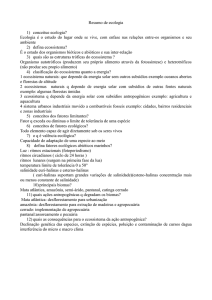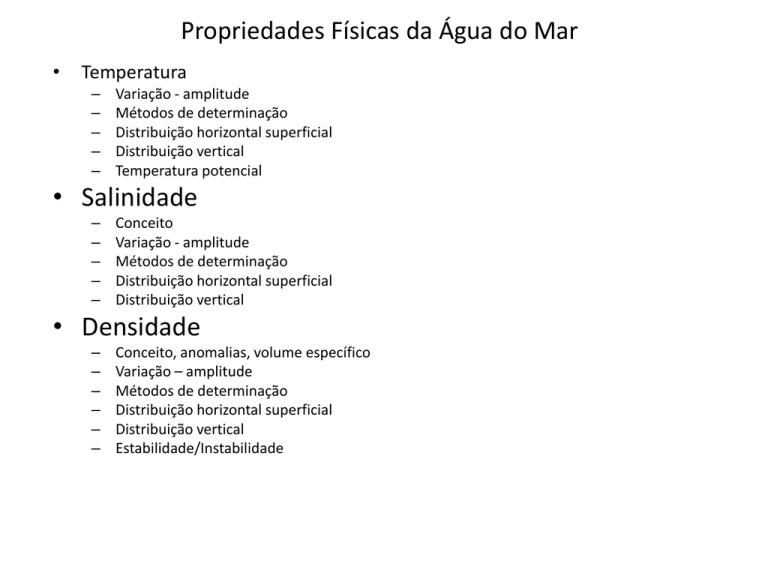
Propriedades Físicas da Água do Mar
•
Temperatura
–
–
–
–
–
Variação - amplitude
Métodos de determinação
Distribuição horizontal superficial
Distribuição vertical
Temperatura potencial
• Salinidade
–
–
–
–
–
Conceito
Variação - amplitude
Métodos de determinação
Distribuição horizontal superficial
Distribuição vertical
• Densidade
–
–
–
–
–
–
Conceito, anomalias, volume específico
Variação – amplitude
Métodos de determinação
Distribuição horizontal superficial
Distribuição vertical
Estabilidade/Instabilidade
Presença do sal na água do mar: impactos
• Altera:
–
–
–
–
–
–
Viscosidade
Compressibilidade – propagação do som
Índice de refração da luz
Densidade
Temperatura de máxima densidade
Ponto de congelamento
Temperatura da Água do Mar
Mean sea-surface temperature calculated from the optimal interpolation technique (Reynolds and Smith,
1995) using shipreports and AVHRR measurements of temperature. Contour interval is1° C with heavy
contours every 5° C. Shaded areas exceed 29° C.
Balanço de Calor
The mean annual radiation and heatbalance of the earth. From
Houghton et al. (1996: 58), which used data from Kiehl and
Trenberth (1996).
FIGURE 5.12
Annual average net heat flux (W/m2). Positive: heat gain by the sea. Negative: heat loss by the sea. Data
are from the NOCS climatology (Grist and Josey, 2003). Superimposed numbers and arrows are the
meridional heat transports (PW) calculated from ocean velocities and temperatures, based on Bryden
and Imawaki (2001) and Talley (2003). Positive transports are northward. The online supplement to
Chapter 5 (Figure S5.8) includes another version of the annual mean heat flux, from Large and Yeager
(2009). This figure can also be found in the color insert.
TALLEY
Copyright © 2011 Elsevier Inc. All rights reserved
Garrafas de Nansen e de Niskin
Termômetros de inversão
Métodos de medição
Bati-Termógrafo
mecânico
eXpendable-BT
Condutividade Temperatura Depth
(Profundidade)
CTD
A medida hidrografica : Roseta + CTD.
O perfil de T/S/Sigma-t resultante
Barcos de oportunidade
Sensoriamento Remoto Espectros de Radiação E.M.
Espectro Visivel: 4000 a 7000 Å ou 400 a 750 μm.
Sol (λ=raios-X)
Sol (λ=UV)
Fonte:http://csep10.phys.utk.edu/
Fonte:http://www.electro-optical.com/
Processos que afetam a medida de TSM
Distribuição horizontal –camada de mistura
Mean sea-surface temperature calculated from the optimal interpolation technique (Reynolds and Smith,
1995) using shipreports and AVHRR measurements of temperature. Contour interval is1° C with heavy
contours every 5° C. Shaded areas exceed 29° C.
Distribuição Vertical da Temperatura
entre 60 S e 60 N
~150 m
Camada de mistura – radiação solar, vento, ondas
e correntes
Termoclina Permanente
onde a T decresce rapidamente –
~1000 m
Essa estrutura é
alterada de acordo com
a latitude. Em médias
latitudes aparece,
também, uma
termoclina sazonal.
Em altas latitudes a
camada de mistura vai,
praticamente, até o
fundo do oceano, com
perfil com decréscimo
suave da T até o fundo
Região profunda
onde a temperatura varia
suavemente
Em função da latitude as zonas se dividem em:
Baixas latitudes Não existem significativas nas estações do ano
T. das H2Os superficiais são sempre altas
Termoclina Permanente
Camada de mistura de pouca espessura.
Divergência Equatorial
Médias latitudes
Termoclina Permanente & sazonal
Verão
Inverno
Termoclina Permanente
Altas latitudes
Inexistência da Termoclina Permanente
T quase Cte ao longo da coluna d´água
Região Subantártica
Mar de Weddell
Resumo da distribuição latitudinal, em profundidade, da
Temperatura
Distribuição de Trítio no Pacífico
Secção transversal no Pacífico Equatorial: termoclina mais rasa
na margem leste do oceano
Temperatura potencial?
É a T corrigida a partir da T in situ principalmente para grandes
profundidades onde existe o efeito da pressão hidrostática.
Z=0m
Z = 500 m
Z = 2000 m
Salinidade da Água do Mar
Salinidade????
É definida como o peso em gramas de material
sólido dissolvido contido em 1 Kg de água do mar
qdo todos os carbonatos foram convertidos a óxidos, os brometos e
iodetos em cloretos e todo material orgânico completamente oxidado.
Métodos de determinação
Salinidade = 1,80655 Cl.
Evaporação [mat orgânica]
Titulação do íon cloro presente na água (clorinidade)
Atualmente condutividade elétrica
adicionados pelas erupções vulcânicas e descarga dos rios ao longo do tempo
geológico.
1. Cl- com 55% do total de material dissolvido,
2. Na+ com 30,6%, sendo que o sal NaCl soma 86%,
3. SO4 - com 7,7%,
4. Mg++ com 3,7%,
5. K+ com 1,1%.
Como determinar a salinidade ?
CLORINIDADE
where chlorinity Cl is defined as “the mass of silver required to precipitate completely
the halogens in 0.328 523 4 kg of the sea-water sample.”
CONDUTIVIDADE
Variação superficial da salinidade: o que causa isso?
Variação da Salinidade
Evaporação, precipitação, aportes continentais, congelamento/degelo
Distribuição horizontal da Salinidade
aproximadamente zonal
Depende do balanço E-P
Max ~20o E>P
Min Equador P>E
S média sup 33.8 e 37.5
Altas latitudes: congelamento/degelo
S superficial média para todos os oceanos e diferenças entre
evaporação e precipitação (E-P) em função da latitude.
Distribuição Vertical da
Salinidade entre 60 S e 60 N
Distribuição Vertical da
Salinidade em altas latitudes –
Mar de Weddell
Distribuição vertical da Salinidade
A distribuição vertical da S em baixas e médias lat é caracterizada por um mín de S entre 600 a 1000 m com um
aumento a partir dos 2000 m
Regiões costeiras onde existe muita descarga fluvial ocorre
geralmente uma camada de água superficial de baixa salinidade
Densidade ???
relação entre a massa de qualquer substância e seu
volume
Variação 1021 kg/m3 na superfície até 1070 kg/m3 no fundo
Conseqüência da Salinidade, Temperatura e Pressão (ρ(S,T,p) é determinada pela
equação de estado da água do mar )
A densidade vai determinar onde uma massa de água vai se estabelecer
Gde parte das correntes oceânicas pode ser adequadamente descrita
conhecendo-se o campo de pressão.
A pressão em um determinado ponto do oceano é definida como o peso
da água acima deste ponto. Este peso, por sua vez, é função da altura
da coluna d’água em questão e da sua densidade.
Cálculo da densidade da água do mar
Distribuição horizontal da Densidade
aumenta de 22 próximo do equador até 26-27 em
50° a 60° de latitude
Oceano aberto (Temperatura) águas com T,
densidade, são geralmente encontradas em
camadas superficiais, e águas com T, densidade,
em camadas profundas.
A da S que ocorre em oceano aberto não tem
efeitos suficientemente importantes para sobreporse ao efeito da temperatura na densidade.
Em águas costeiras (fjords, lagoas e estuários), a S é
sempre o fator controlador na determinação da
densidade, em todas as profundidades.
Increase in density with pressure for a water parcel of temperature
0°C and salinity 35.0 at the sea surface.
Distribuição vertical da Densidade
Equador: Picnoclina saliente/ camada de mistura peq
Trópicos: Camada de mistura maior/picnoclina pouco saliente
Pólos: Picnoclina muito peq (apenas devido às variações de S)
Estabilidade/instabilidade na coluna de água
•
•
•
•
Conceitos: estável, neutro, instável
O número E – ondas internas – a frequência de Brünt-Väisälä
Geração de instabilidade
Processo de Dupla-difusão
A equação da estabilidade estática:
E > 0 Estável
E = 0 Neutro
E < 0 Instável
In the upper kilometer of the ocean, z < 1,000m, E =
(50-1000)×10-8/m, and in deep trenches where z >
7,000m, E = 1×10-8/m.
Billow clouds showing a Kelvin-Helmholtz instability at the top
of a stable atmospheric boundary layer. Some billows can
become large enough that more dense air overlies less dense
air, and then the billows collapse into turbulence.
Photography copyright Brooks Martner, NOAA Environmental
Technology Laboratory.
Ondas internas no Saint Lawrence Estuary:Largeamplitude internal waves (see image to the right)
may be generated by stratified tidal flows over
bottom topographic features. It is thought that such
waves may be an important source of mixing in
coastal waters, which means that they play a key role
in coastal ecosystems, circulation, pollutant
dispersal, etc.
http://iod.ucsd.edu/research/iwaves/
http://www.es.flinders.edu.au/~mattom/Intro
Oc/notes/figures/animations/fig10a7c.html
Double Diffusion and Salt Fingers
In some regions of the ocean, less dense water overlies
more dense water, yet the water column is unstable even if
there are no currents. The instability occurs because the
molecular diffusion of heat is about 100 times faster than the
molecular diffusion of salt. The instability was first discovered
by Melvin Stern in 1960 who quickly realized its importance
in oceanography.
Consider two thin layers a few meters thick separated by a
sharp interface. If the upper layer is warm and salty, and if
the lower is colder and less salty than the upper layer, the
interface becomes unstable even if the upper layer is less
dense than the lower.
Warm salty over colder less salty. This process is called salt fingering It occurs in
central waters of sub-tropical gyres, western tropical North Atlantic, and the Northeast Atlantic beneath the out flow from the Mediterranean Sea. Salt fingering
eventually leads to density increasing with depth in a series of steps. Layers of
constant-density are separated by thin layers with large changes in density, and
the profile of density as a function of depth looks like stair steps. Schmitt et al.,
(1987) observed 5-30m thick steps in the western, tropical North Atlantic that were
coherent over 200-400km and that lasted for at least eight months. Kerr (2002)
reports a recent experiment by Raymond Schmitt, James Leswell, John Toole, and
Kurt Polzin showed salt fingering o Barbados mixed water 10 times faster than
turbulence.
Colder less salty over warm salty. This process is called diffusive convection. It is
much less common than salt fingering, and it us mostly found at high latitudes.
Diffusive convection also leads to a stair step of density as a function of depth.
Here's what happens in this case. Double diffusion leads to a thin, warm, less-salty
layer at the base of the upper, colder, less-salty layer. The thin layer of water rises
and mixes with water in the upper layer. A similar processes occurs in the lower
layer where a colder, salty layer forms at the interface. As a result of the convection
in the upper and lower layers, the interface is sharpened; and any small gradients
of density in either layer are reduced. Neal et al. (1969) observed 2-10m thick
layers in the sea beneath the Arctic ice.
Cold salty over warmer less salty.
Warmer less salty over cold salty.
Salt Fingering e Cabelling



